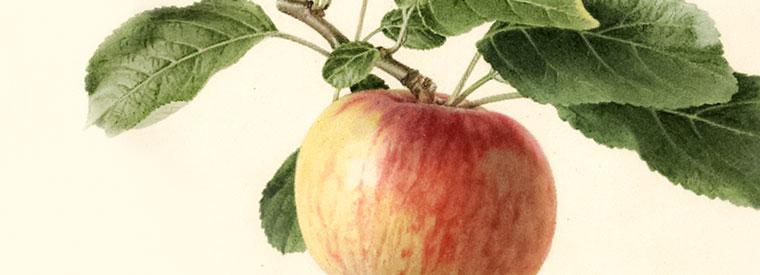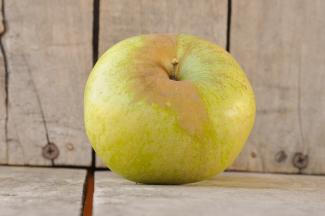Fine fruit is the most perfect union of the useful and the beautiful that the earth knows.

Fruit
ALBEMARLE PIPPIN, the most famous of Virginia apples, originated in 1700 near the village of Newtown on Long Island, New York.
Col. Thomas Walker of Castle Hill brought scions of the variety back to Albemarle County as he returned from service under General Washington at the battle of Brandywine in 1777. It was grown widely in Virginia by the end of the18th century by agriculturists, including George Washington, John Hartwell Cocke, and Thomas Jefferson.
The crisp, juicy, firm flesh and very distinctive taste, along with its excellent keeping qualities, made the Pippin the most prized of American dessert apples from the early 18th century. It grows especially well in the Virginia Piedmont and attracted great notoriety when Andrew Stevenson, the American minister to St. James, presented the young Victoria with a gift basket of the apples in 1838 from his wife's Albemarle County home, Enniscorthy. "Never did a barrel of apples obtain so much reputation for the fruits of our country," Sallie Coles Stevenson reported.
As a gesture of appreciation, Parliament permitted the Virginia apple to enter Britain duty-free, and the Albemarle Pippin became an important export, commanding premium prices in the English market. After World War I, Parliament levied duties again on non-Commonwealth fruit, and the Pippin's market waned.
It is difficult to find today, but when well-grown, remains one of the world's finest apples. Unfortunately, the Pippin is not easy to grow, and as its export market shrank, and food distribution came to be dominated by large chains, it was superseded by easier to manage crops such as the now ubiquitous Delicious varieties. For the connoisseur who prizes a rich, complex flavor and firm, juicy texture, this apple has few peers.
Ripening Period
- Mid Fall - October


